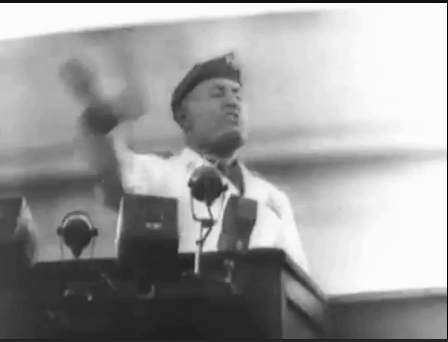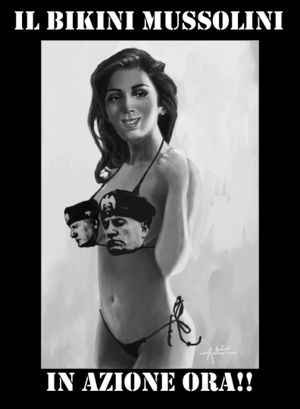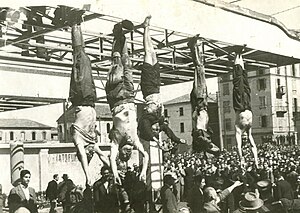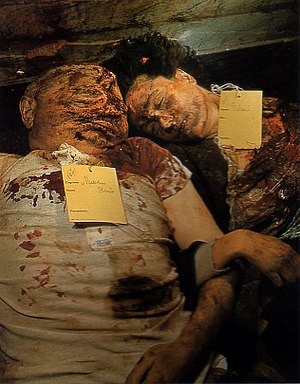Benito Mussolini
Benito Amilcare Andrea "The Moose" Mussolini (29 July 1883 – 28 April 1945) was an Italian politician, journalist, Mario Brother, and the batshit dictator of Italy from 1922 until his execution in 1945. Mussolini was the original fascist (after all, he popularised the term), but always lived in the shadow of his rival/gay lover Adolf Hitler.
Political career
While Hitler had a superficial connection with socialism, being a member of the German Workers' Party and then the National Socialist German Workers' Party, Mussolini actually was a socialist at first: he was the leading member of the National Directorate of the Italian Socialist Party (PSI). Like Hitler, however, Mussolini would be injured in World War I and from then on it all went a bit right wing.
Mussolini switched from believing that class transcended all national borders to deciding that the war had meant the concept of the nation transcended all class borders, a change in attitude known in Italian as "il switcheroo". More Italian: he took the concept of "fascio", meaning a bundle of sticks,[1] from 19th century revolutionary groups, and popularised the term fascismo, publishing his ideas in a newspaper called Il Popolo d'Italia, which, despite sounding like a lovely authentic family restaurant that serves pasta made fresh on-site, was a hate-spewing rag.
The concept of Fascism was very loosely defined, something which has proved an absolute nightmare for history students, who have been asked "What is fascism?", "Was Mussolini a fascist?" and "Is it accurate to describe all of Western Europe's dictators in the 1930s as fascist?" ever since.
In 1922, he demonstrated mass opposition to then-Prime Minister Luigi Facta[2] by leading the March On Rome, an act which would be much more dangerous today given Italian motorcyclists' approach to road safety.
King Victor Emmanuel III reacted curiously to the march: he refused Facta's request to declare martial law, accepted the Prime Minister's resignation, and offered Mussolini the chance to form a government. Mussolini accepted and led a vaguely democratic government for four years, still an Italian record.[3]
Dictatorship
By 1925, Mussolini had grown weary of maintaining the thinly-veiled pretence of democracy, and declared himself a dictator, Il Duce, not realising that the name would be a source of amusement to American schoolchildren some seven decades later.
Benito aspired to re-create the Roman Empire, and began by invading the glorious kingdoms that had made Rome a superpower: Ethiopia and Albania.
The 1935 campaign in Ethiopia was relatively easy, given that the locals were malnourished, scantily-clad and mostly fought with spears. Only 10,000 Italians died in the campaign, and less than 50,000 deserted as they seized a country with a GDP the size of an average Starbucks.
Buoyed by this step forward, Mussolini deployed military forces into Albania in 1939. Monstrous, industrialised European superpowers with highly-trained armies were entirely absent from this conflict, which can be best summed up as: the incompetent beat the defenceless.
Perhaps after reflecting on his army's less impressive performance in a country where several people owned revolvers and trousers, Mussolini employed a policy of smiling and nodding at rising star Adolf Hitler, without every committing himself to fighting a war against anyone big.
World War 2
Some 12 months later, in 1940, Mussolini swept into south-east France after the French had surrendered, and a German puppet government, Vichy France, was in power. Mussolini then tried to push into Greece but did not realise that World War One tanks weren't effective on mountainous terrain and had to ask Hitler for some help. Greece promptly fell.
In 1941, Mussolini drove his military into British-held Egypt. Unfortunately, water and supplies were forgotten and the entire army was lost before a single British soldier was spotted.
As Italy's involvement in the war stretched into a second exhausting year, it became clear that the country did not have much in the way of raw materials for building arms. Always a keen military strategist, Mussolini took to begging Hitler to make peace with the Russians, in order that the Germans could help with stemming the Allied invasion coming in from Northern Africa.
When the Allied invasion force rolled into Italy in 1943, Mussolini boldly ordered the army to crush the enemies, but before he could finish the sentence he was deposed and sent to jail. Marshal Pietro Badoglio took control of the country, and maintained the impressive juggling act of publicly supporting the Nazis while simultaneously signing an Armistice with the Allies. The fascist party was dissolved, and Italians rejoiced, having not enjoyed the war particularly. However, the joy was short-lived, as the Nazis promptly invaded Italy, and the Italian government bravely declared war on Germany. From Malta.
Mussolini was moved from prison to prison in an attempt to keep his location a secret, but was fatefully granted his right to a phone call. He called Hitler and asked to be bailed out. The German Army broke him out of jail, took over Northern Italy, and declared Mussolini the leader of a new puppet state, the Salò Republic.
Mussolini's glorious reign lasted for another two years, but, in an odd correlation, he was deposed and arrested at around the same time Nazi Germany started to crumble.
Death
“He's hanging from a lamppost at the corner of the street...”
Mussolini and his lover, Clara Petacci, were killed, possibly by British spies,[4] soon afterwards in the small but perfectly formed town of Dongo.[5] Their bodies were taken to Milan, where, in possibly the most Catholic move ever, the locals hung them upside down John-the-Baptist style, and then proceeded to throw stones at them. Just two days later, Hitler died. It was a bad week for fascism.
After several days of the crowd stoning Mussolini, one of Il Duce's most loyal men, the excellently-named Achille Starace, was brought before his former leader, who could no longer be considered to be in possession of classical good looks. Starace, to his credit, managed a dignified salute to what now closely resembled a bloodied sack of potatoes, before being shot and hung next to Mussolini.
Mussolini's body was then laid respectfully to rest. Oh, no, wait...
First, the photo below right was taken in the local morgue, demonstrating that recent events hadn't just changed the face of Italy. It actually earned Mussolini his final honour, as he was posthumously awarded an Oscar for Face Which Most Looks Like A Sofa Cushion, an Academy Award which has since been discontinued. Many modern day fascist sympathisers prefer to liken his death-face to a bowl of spaghetti, suggesting that this was the final act of a great Italian patriot.
Mussolini's body was then laid respectfully to rest. Oh, no, wait...
In an attempt to avoid creating a site of pilgrimage for the country's extremists, the Italian government had Mussolini buried in an unmarked grave in the Musocco cemetery, north of Milan. However, Neo-fascist[6] Domenico Leccisi, along with a couple of amici, dug Mussolini up and went on the run with his corpse. In possibly the most Catholic move ever, this was done on Easter Sunday.
Il Duce's body was finally recovered in August, hidden in a small trunk at the Certosa di Pavia, just outside Milan. In possibly the most Catholic move ever, two Fransciscan brothers were the ones caught with the corpse, though it was discovered on further investigation that Mussolini had been constantly on the move, like an Italian fascist version of the school hamster.
Mussolini's body was then laid respectfully to rest. Oh, no, wait...
The government dithered over what to do with the body and, incredibly, it was held in an unknown location for ten years. He was reinterred, in his family's mausoleum, in 1957. Coincidentally, the Prime Minister of Italy at this time, Adone Zoli, who made the decision to give Mussolini a dignified burial, was desperately in need of parliamentary support from Italy's still-popular far-right parties.
Even more coincidentally, one such member of parliament was named Domenico Leccisi.
Benvenuto in Italia!
Footnotes
- ↑ It probably sounds better in Italian.
- ↑ Whose surname offers the opportunity to make jokes with the punchline "fucked-ah" pronounced in a cod-Italian accent.
- ↑ Check out this list of numb-nuts.
Number Name
(Born–Died)Term of office Took office Left office Time in office 31 Giuseppe Pella (1902–1981) 17 August 1953 18 January 1954 0 years , 154 days
32 Amintore Fanfani (1908–1999) 18 January 1954 10 February 1954 0 years , 23 days
33 Mario Scelba (1901–1991) 10 February 1954 6 July 1955 1 year , 146 days
34 Antonio Segni (1891–1972) 6 July 1955 19 May 1957 1 year , 317 days
35 Adone Zoli (1887–1960) 19 May 1957 1 July 1958 1 year , 43 days
(32) Amintore Fanfani (1908–1999) 1 July 1958 16 February 1959 0 years , 230 days
(34) Antonio Segni (1891–1972) 16 February 1959 25 March 1960 1 year , 38 days
36 Fernando Tambroni (1901–1963) 25 March 1960 26 July 1960 0 years , 123 days
(32) Amintore Fanfani (1908–1999) 26 July 1960 21 February 1962 2 years , 330 days
21 February 1962 21 June 1963 37 Giovanni Leone (1908–2001) 21 June 1963 4 December 1963 0 years , 166 days
38 Aldo Moro (1916–1978) 4 December 1963 22 July 1964 4 years , 203 days
22 July 1964 23 February 1966 23 February 1966 24 June 1968 (37) Giovanni Leone (1908–2001) 24 June 1968 12 December 1968 0 years , 171 days
39 Mariano Rumor (1915–1990) 12 December 1968 5 August 1969 1 year , 237 days
5 August 1969 27 March 1970 27 March 1970 6 August 1970 40 Emilio Colombo (1920–2013) 6 August 1970 17 February 1972 1 year , 195 days
41 Giulio Andreotti (1919–2013) 17 February 1972 26 June 1972 1 year , 140 days
26 June 1972 7 July 1973 (39) Mariano Rumor (1915–1990) 7 July 1973 14 March 1974 1 year , 139 days
14 March 1974 23 November 1974 (38) Aldo Moro (1916–1978) 23 November 1974 12 February 1976 1 year , 249 days
12 February 1976 29 July 1976 (41) Giulio Andreotti (1919–2013) 29 July 1976 11 March 1978 3 years , 6 days
11 March 1978 20 March 1979 20 March 1979 4 August 1979 42 Francesco Cossiga (1928–2010) 4 August 1979 4 April 1980 1 year , 75 days
4 April 1980 18 October 1980 43 Arnaldo Forlani (1925–) 18 October 1980 28 June 1981 0 years , 253 days
44 Giovanni Spadolini (1925–1994) 28 June 1981 23 August 1982 1 year , 156 days
23 August 1982 1 December 1982 (32) Amintore Fanfani (1908–1999) 1 December 1982 4 August 1983 0 years , 246 days
45 Bettino Craxi (1934–2000) 4 August 1983 1 August 1986 3 years , 257 days
1 August 1986 18 April 1987 (32) Amintore Fanfani (1908–1999) 18 April 1987 29 July 1987 0 years , 102 days
46 Giovanni Goria (1943–1994) 29 July 1987 13 April 1988 0 years , 259 days
47 Ciriaco De Mita (1928–) 13 April 1988 22 July 1989 1 year , 100 days
(41) Giulio Andreotti (1919–2013) 22 July 1989 12 April 1991 2 years , 342 days
12 April 1991 28 June 1992 48 Giuliano Amato (1938–) 28 June 1992 28 April 1993 0 years , 304 days
49 Carlo Azeglio Ciampi (1920–2016) 28 April 1993 10 May 1994 1 year , 12 days
50 Silvio Berlusconi (1936–) 10 May 1994 17 January 1995 0 years , 252 days
51 Lamberto Dini (1931–) 17 January 1995 17 May 1996 1 year , 121 days
52 Romano Prodi (1939–) 17 May 1996 21 October 1998 2 years , 157 days
53 Massimo D'Alema (1949–) 21 October 1998 22 December 1999 1 year , 187 days
22 December 1999 25 April 2000 (48) Giuliano Amato (1938–) 25 April 2000 11 June 2001 1 year , 47 days
(50) Silvio Berlusconi (1936–) 11 June 2001 23 April 2005 4 years , 340 days
23 April 2005 17 May 2006 (52) Romano Prodi (1939–) 17 May 2006 8 May 2008 1 year , 357 days
(50) Silvio Berlusconi (1936–) 8 May 2008 16 November 2011 3 years , 192 days
54 Mario Monti (1943–) 16 November 2011 28 April 2013 1 year , 163 days
55 Enrico Letta (1966–) 28 April 2013 22 February 2014 0 years , 300 days
56 Matteo Renzi (1975–) 22 February 2014 12 December 2016 2 years , 294 days
57 Paolo Gentiloni (1954–) 12 December 2016 1 June 2018 1 year , 171 days
58 Giuseppe Conte (1964–) 1 June 2018 5 September 2019}} 2 years , 257 days
5 September 2019}} 13 February 2021}} 59 Mario Draghi (1947–) 13 February 2021 Incumbent 4 years , 7 days
- ↑ No one does conspiracy theories better than Italians. https://en.wikipedia.org/wiki/Death_of_Benito_Mussolini#Post-war_controversy
- ↑ In Italy's Innuendo region. https://en.wikipedia.org/wiki/Dongo,_Lombardy
- ↑ Perhaps the world's first neo-fascist, bearing in mind fascism had only just popped its clogs.





